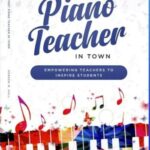
I wrote this post a while back and never published it. I was worried about being too…I don’t know…controversial.
I totally respect the scientific community and all of those people who dedicate their lives to finding ways to help people learn. I know there are outstanding teaching techniques, therapies, and medications that can help people who struggle with issues that keep them from achieving their highest potential. I believe we should work together and explore all avenues that can lead to success for our students.
No More Labels Please – Tips for Working With Special Needs Piano Students.
“She’s a ‘special-needs’ learner”
“He is a ‘gifted’ child”
“She is ‘difficult, oppositional, temperamental’” …fill in the blank.
There may be a very real diagnosis. Like ADD, or Autism. I get that. I understand. (Really, if you knew my family history and my teaching experience you would see I am no stranger to this.)
Ever wonder why a lot of parents don’t tell you about their child’s diagnosis?
They want you to see their children as people. Just regular kids.
I am a teacher.
My job is to impart knowledge.
In my case musical knowledge.
My job is to figure out how I can help my students learn. Because I believe, everyone can learn something, and just about everyone can learn to play some music.
So personally, I don’t want to know what my student may be labeled before I meet him. I want to get to know him for myself. So far, in 36 years of teaching all kinds of people, I have yet to come across someone who couldn’t learn.
I see all of my students as human beings, just like me. Good at some things, not so great at others. Every single one is a treasure chest full of potential. Figuring out how to unlock it is my responsibility,
So, I say,
“Come on down… What’s your name?”
Mine is Doreen.
Here are some of the ways I have found success with all of my students.
1 – I prefer not to know too much about a diagnosis or exceptionality before I meet any student. I honestly believe I can find a way. I can work with any student who is willing to work with me.
2 – See everyone as equal. Everyone is equal. Sometimes I may have to change the ways I present things but as I see it, this is part of being a good teacher anyway. I do this with every student.
3- Take your cues from the student. I always ask all of my students what they are trying to get out of the lessons. If the student is non-verbal, take a step back and give them a chance to explore a bit. I keep hands-on activities and games on hand, I can play for them if they are not ready to try playing for me. Maybe, a student just wants to sit quietly while I talk to Mom or Dad. I am always mindful that the student is in the room.
4 – Start with easy. I do this with all of my students. It is much better to give a student an easy task and level up than to have them fail and then pull back. Maybe an easy task is just learning the right and left hand.
5 – Celebrate success! Did my student learn a new note or a whole new piece? Can she clap a steady beat? Point this out and give a high-five! Again, I do this with every student.
6 – Get ready to be amazed! Yep, get ready. I have discovered students with photographic memories, perfect pitch, outstanding rhythmic abilities, beautiful singing voices, improvisational abilities, and young composers. I have learned never to underestimate anyone.
7 – Expect the best. Never set limits. Hold every student to a personal level of excellence.
8 – Partner with parents. Listen to and support parents and caregivers. I assure them that I hear their concerns. I always try to remember to share successes with them.
9 – Focus on the positive. Don’t sweat the small stuff. If there is a minor problem, I try to redirect my student’s attention to the task at hand.
10 – Trust. I am a teacher and a human being I am not perfect I am always learning to be better than I was the day before. I believe that I can find a way to reach any student who is willing to be reached.
11 – Lean on the piano community. I am so fortunate to live in a time where I can email a colleague, search the internet, or ask my Facebook friends for advice and suggestions. I have learned so much from this.
12 – Remember the words of Dr. Sinichi Suzuki “Where love is deep, much can be accomplished” I learned this many years ago and I have found it to be true indeed.
Here are my books
For great hands-on activities for all students
If you would like to find out about becoming a member of Paloma Piano we have a number of very attractive membership options including a free membership that offers a large number of piano scores, teaching resources, and games. The free membership is forever free and no credit card is needed. Check it out!




Comments & Discussion